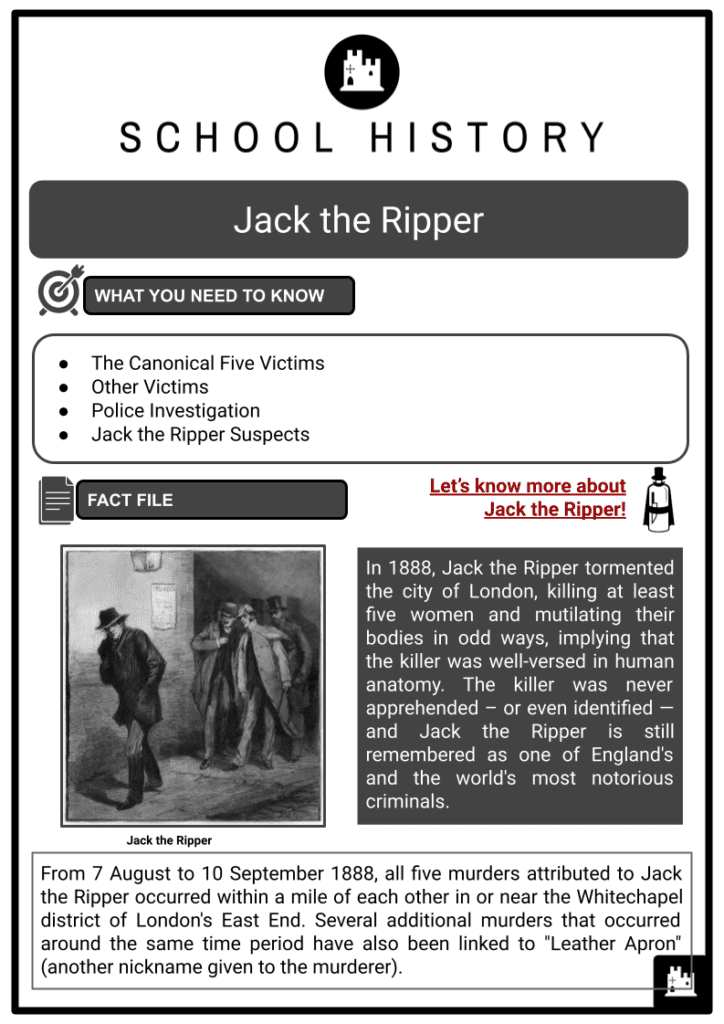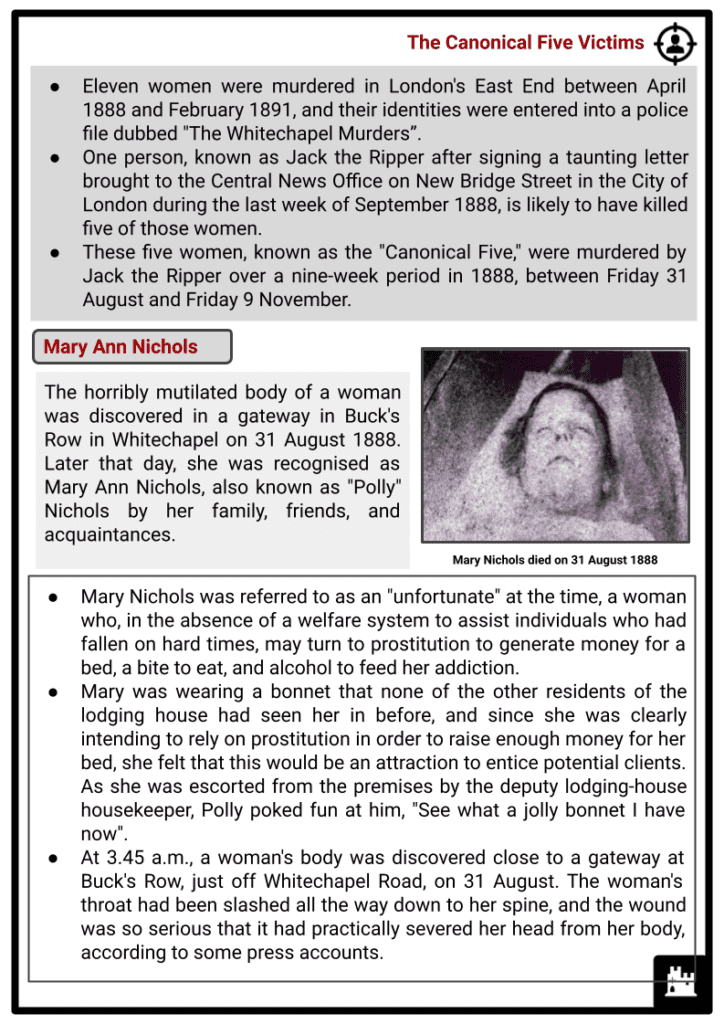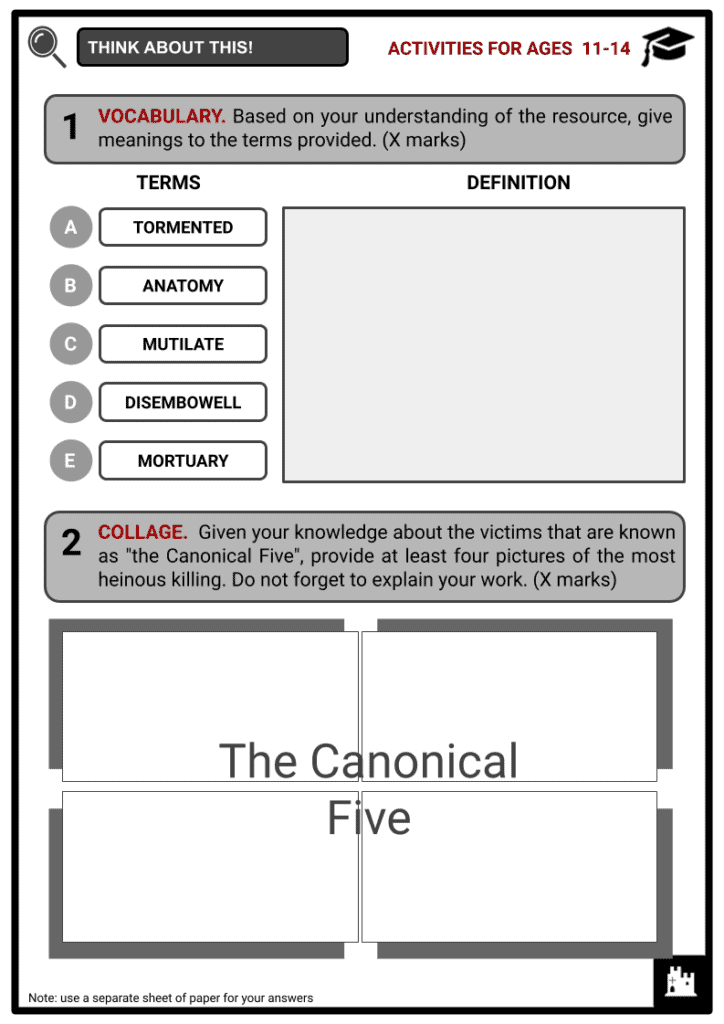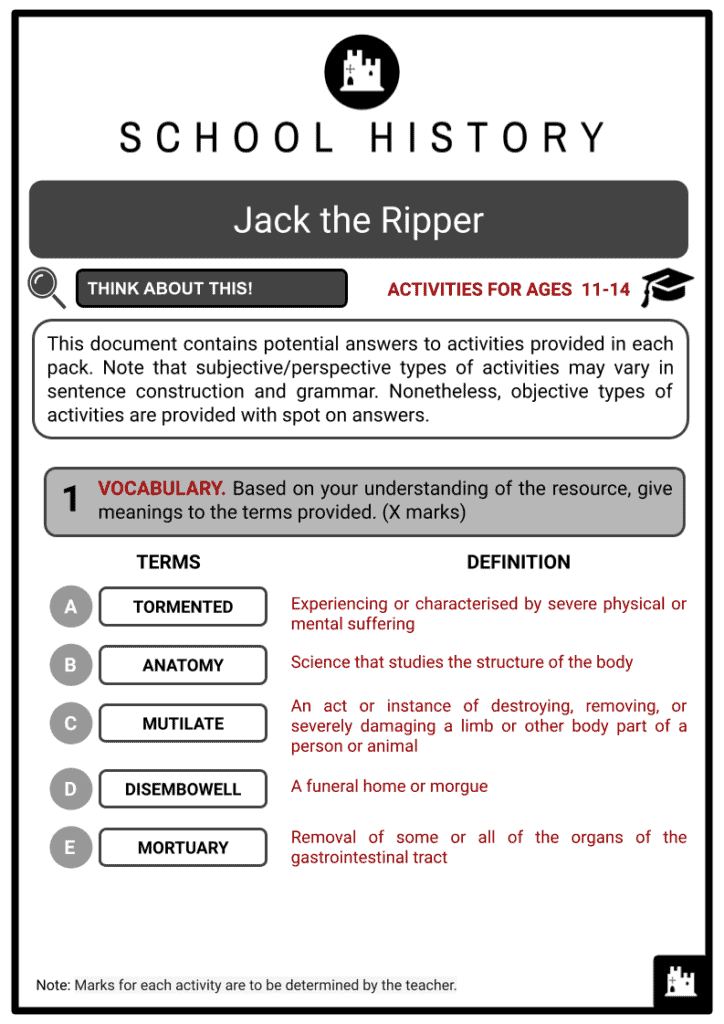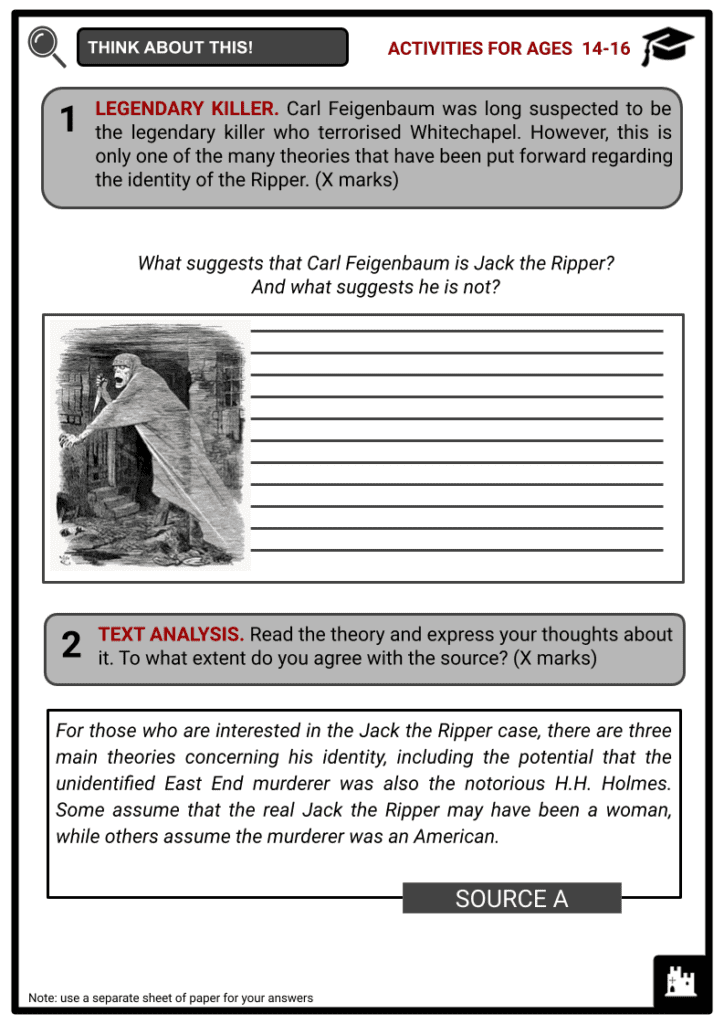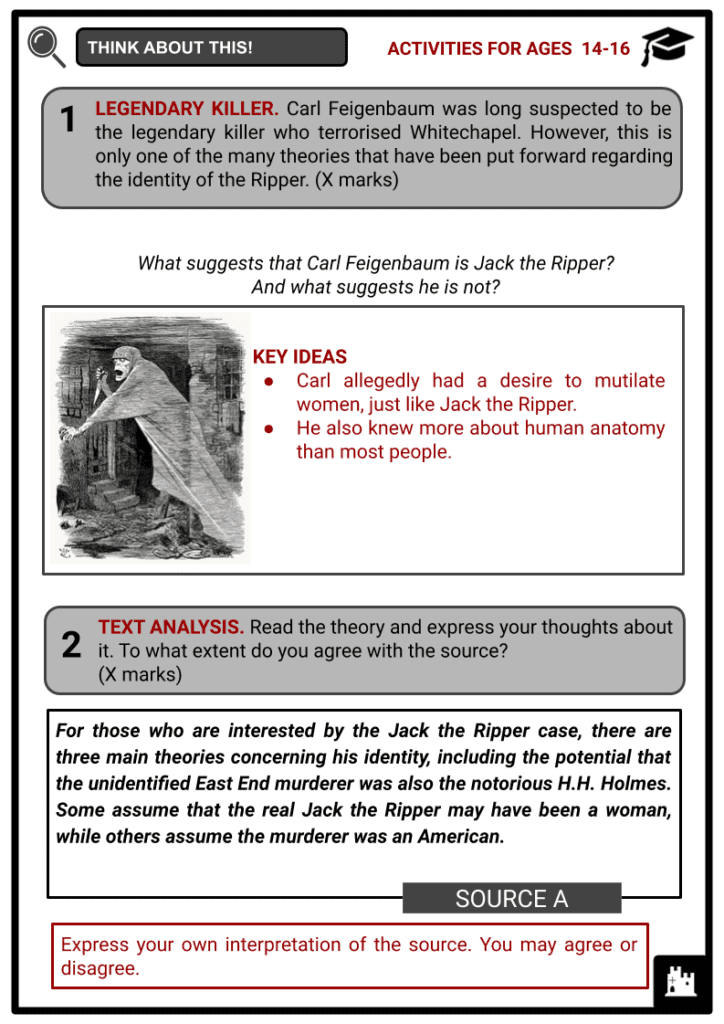Jack the Ripper Worksheets
Do you want to save dozens of hours in time? Get your evenings and weekends back? Be able to teach about Jack the Ripper to your students?
Our worksheet bundle includes a fact file and printable worksheets and student activities. Perfect for both the classroom and homeschooling!
Summary
- The Canonical Five Victims
- Other Victims
- Police Investigation
- Jack the Ripper Suspects
Key Facts And Information
Let’s find out more about Jack the Ripper!
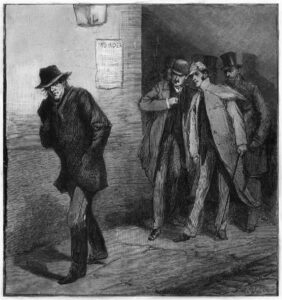
In 1888, Jack the Ripper tormented the city of London, killing at least five women and mutilating their bodies in odd ways, implying that the killer was well-versed in human anatomy. The killer was never apprehended – or even identified — and Jack the Ripper is still remembered as one of England's and the world's most notorious criminals.
From 7 August to 10 September 1888, all five murders attributed to Jack the Ripper occurred within a mile of each other in or near the Whitechapel district of London's East End. Several additional murders that occurred around the same time period have also been linked to "Leather Apron" (another nickname given to the murderer).
The Canonical Five Victims
- Eleven women were murdered in London's East End between April 1888 and February 1891, and their identities were entered into a police file dubbed "The Whitechapel Murders”.
- One person, known as Jack the Ripper after signing a taunting letter brought to the Central News Office on New Bridge Street in the City of London during the last week of September 1888, is likely to have killed five of those women.
- These five women, known as the "Canonical Five," were murdered by Jack the Ripper over a nine-week period in 1888, between Friday 31 August and Friday 9 November.
Mary Ann Nichols
- The horribly mutilated body of a woman was discovered in a gateway in Buck's Row in Whitechapel on 31 August 1888. Later that day, she was recognised as Mary Ann Nichols, also known as "Polly" Nichols by her family, friends, and acquaintances.
- Mary Nichols was referred to as an "unfortunate" at the time, a woman who, in the absence of a welfare system to assist individuals who had fallen on hard times, may turn to prostitution to generate money for a bed, a bite to eat, and alcohol to feed her addiction.
- Mary was wearing a bonnet that none of the other residents of the lodging house had seen her in before, and since she was clearly intending to rely on prostitution in order to raise enough money for her bed, she felt that this would be an attraction to entice potential clients. As she was escorted from the premises by the deputy lodging-house housekeeper, Polly poked fun at him, "See what a jolly bonnet I have now".
- At 3.45 a.m., a woman's body was discovered close to a gateway at Buck's Row, just off Whitechapel Road, on 31 August. The woman's throat had been slashed all the way down to her spine, and the wound was so serious that it had practically severed her head from her body, according to some press accounts.
- She was loaded into a police ambulance and sent to the nearby Whitechapel Workhouse Infirmary mortuary within 45 minutes. Inspector Spratling of the Metropolitan Police's J Division came to take down a report of the, at the time, unidentified victim, and he discovered the woman had been disembowelled, in addition to the awful throat wound.
Annie Chapman
- Annie Chapman (1841–1888) lived a wandering existence in the Spitalfields area. She was 47 years old when she died, a short chubby, ashen-faced consumptive who had been staying at Crossingham's lodging house at number 35 Dorset Street for four months or so, paying eight pence a night for a double bed. Annie seemed to have had a friendly relationship with the other residents, and the deputy keeper, Timothy Donovan, remembers her as a pleasant soul with a penchant for alcohol.
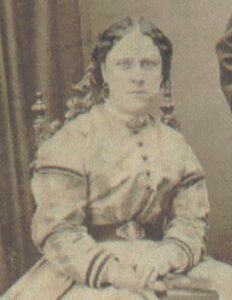
Annie Chapman - Annie supported her meagre income of crocheting and creating and selling artificial flowers with prostitution, as did many other women in the neighbourhood.
- She had two frequent clients, one known as Harry the Hawker and the other a man named Ted Stanley, a reputable retired soldier dubbed "the Pensioner" by her fellow lodgers.
- Stanley would frequently spend Saturdays through Mondays at Crossingham's, according to a witness, Timothy Donovan.
- There had been an argument between Annie and fellow lodger Eliza Cooper sometime in the month before her death (various witnesses reported different dates). The circumstances of the argument as reported by the many witnesses are confusing and conflicting, with some even alleging that Harry the Hawker was to blame.
- Annie Chapman's health was deteriorating, and she spent her final days injured and in pain. The bruising to her right temple was visible when she met her friend Amelia Palmer on Dorset Street on Monday, 3 September.
Elizabeth Stride
- The last day of Elizabeth or "Long Liz" Stride's life was spent tidying rooms in the lodging house at 32 Flower and Dean Street, where she had stayed on and off for the past six years. Elizabeth Tanner, the deputy keeper, paid her sixpence for the duties, and by 6.30 p.m, she was quenching her thirst at the Queen's Head tavern on the corner of Fashion and Commercial Streets.
- By 7 p.m., she had returned to the lodging house and was dressed "ready to go out", and departed the lodging house at 7.30 p.m. according to fellow resident Charles Preston.
- William Marshall, a labourer who resided at number 64 Berner Street, was standing outside his home around 11.45 p.m. when he observed a man and woman outside number 63. They appeared to be pretty sober, and as he stood there watching, they began to kiss. "You would utter anything but your prayers," the man said to the woman, according to Marshall, as the couple walked away toward Dutfield's Yard. The individual was described by Marshall as being middle-aged, heavy, and having the appearance of a clerk. He was around 5 feet 6 inches tall, shaved, and dressed properly.
- PC William Smith was on his route at 12.30 a.m. when he observed a man and a woman on the opposite side of Berner Street from Dutfield's Yard, where Elizabeth Stride's body was later recovered. The woman Smith later identified as Elizabeth Stride, had a flower pinned to her jacket.
- A Hungarian Jew named Israel Schwartz was the most important witness to have seen Elizabeth Stride in the 30 minutes before her body was recovered in Dutfield's Yard.
- Around 12.45 a.m., he drove into Berner Street and observed a man walking in front of him. According to Schwarz, the man attempted to drag the woman into the street, but instead twisted her around and flung her down the sidewalk, where she shouted three times but not loudly. Israel Schwartz appears to have thought he was seeing a domestic attack and crossed the street to avoid becoming involved.
Catherine Eddowes
- Another prostitute named Catherine or "Kate" Eddowes was being released from Bishopsgate Police Station in the City of London at almost the same time as Elizabeth Stride's body was discovered in Dutfield's Yard.
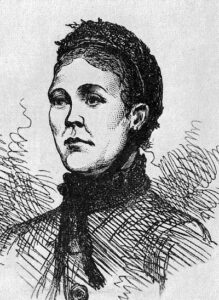
Catherine “Kate” Eddowes - In September 1888, Eddowes and John Kelly returned to Hunton, Kent, for their yearly practice of hop-picking. On 27 September, the two arrived in London and stayed overnight in the casual ward at Shoe Lane in the City of London. The following night, the two slept in separate lodging houses:
- Eddowes told Kelly of her plans to visit Bermondsey in the early afternoon on 29 September. At around 2 p.m., the two parted ways in Houndsditch.
- Prior to her death, Eddowes was reportedly seen by three men on the evening of 29 September. Only 10 minutes before her body was discovered, she was spotted conversing with a man at one of the entrances at Mitre Square.
- PC Edward Watkins of the City Police discovered Catherine Eddowes' mutilated body at 1.44 a.m. Her body was discovered in the darkest area of Mitre Square, which at the time was an isolated, poorly lit space dominated by tall warehouses.
- Her throat had been severed to the spine, her abdomen opened, and bits of her intestines were discovered all over her body. Her uterus and left kidney had been removed and taken from the scene of the murder, and her face had been carefully sliced with several seemingly purposeful wounds.
- Jack the Ripper had about ten minutes between seeing Catherine Eddowes chatting to the man and PC Watkins discovering her body. He'd have had to catch Eddowes, inflict the vast and difficult injuries, then flee without being seen or overheard in under ten minutes. The murder was swift and quiet, causing no disruption to those in the surrounding buildings.
- The gruesome yet precise injuries inflicted on Eddowes have been used as indicators in later years to demonstrate Jack the Ripper's alleged anatomical competence. This was not proven, and the matter is still debated today.
- The post-mortem investigation of the body of Catherine Eddowes included a variety of medical professionals. Unfortunately, the physicians' perspectives on the amount of medical and anatomical expertise revealed by the injuries were all different, leading detectives to a dead-end once again.
Mary Jane Kelly
- Mary Jane Kelly was born in Limerick, Ireland, and married at the age of 16 to a man called Davies after her family migrated to Wales. Her husband was killed in a mine explosion just a few years later, leaving her widowed.
- Mary Jane Kelly then relocated to Cardiff, where she allegedly became involved in prostitution and is said to have spent time with a wealthy Londoner. She followed the man to Paris at this time, despite her dislike for the city. According to reports, she also went under the name 'Marie Jeanette' and lived a lady's life.
- In 1887, Mary met Joseph Barnett, a costermonger. When Barnett lost his job, the couple's relatively stable life was disrupted. As a result, Mary had to return to the streets to make a living, something Barnett, predictably, disapproved of. Living for the couple became increasingly difficult, from this point forward, with disagreements becoming more regular and violent, especially when Mary had been drinking.
- Barnett moved out and found new lodgings. Despite their split, the couple remained friendly, and Barnett would assist Mary financially whenever he could. This, however, was insufficient to keep her off the streets and ensure she could pay her rent on time. On the evening of 8 November 1888, Joseph would pay his final visit to Mary.
- On 9 November 1888, at 11.45 a.m., landlord John McCarthy dispatched his helper, Thomas Bowyer, to Room 13 to collect Mary's outstanding rent arrears.
- Bowyer knocked on Mary's room door but received no response, so he went around to the windows. He reached inside to pull the curtain aside after noticing the broken pane of glass. Bowyer peered into the dim light of the room and saw Mary Jane Kelly's body on the bed, ripped and cut to shreds.
- "The entire portion of the abdomen and thighs were taken, as well as the viscera from the abdominal cavity. The breasts were removed, the limbs were mutilated by several jagged incisions, and the face was slashed beyond recognition. The neck tissues were cut all the way down to the bone. The uterus and kidneys were discovered with one breast under the head, the other breast by the right foot, the liver between the feet, the intestines by the right side of the body, and the spleen by the left side. The belly and thigh flaps were on a table...The pericardium was exposed below and the heart was missing."
The Final Jack the Ripper Victim?
- Because crime scenes were photographed, Mary Jane Kelly's murder stands out as the only one by Jack the Ripper when the long process of photography – as it was practised at the time – was feasible.
- Mary's funeral service was held at St. Patrick's Roman Catholic Cemetery in Leytonstone on 19 November.
- The idea of Mary Jane Kelly as a young life tragically cut short — she was the youngest victim of the Yorkshire Ripper at only 25 – has contributed to sustaining popular interest in the case even today.
- Many people seem to believe that Mary Jane Kelly's horrific murder on 9 November 1888 was the end of Jack the Ripper's terror, but we must remember that as the weeks, months, and even years went by with the Ripper still uncaught, the very real possibility of another homicide hung over the city at all times.
Other Victims
Martha Tabram
- Martha Tabram was assumed to be associated with the Jack the Ripper murders for a long time before her identity and the nature of her death even though she is not one of the Canonical Five. Martha Tabram was discovered on a landing in George Yard on 7 August 1888, with 39 individual knife wounds from two different weapons. Her status as a prostitute in Whitechapel and the treatment she received were factors that initially made her death appear to be related to the Jack the Ripper killings. However, a later finding in the mid-20th century resulted in a universal opinion that she was unlikely to be the first Jack the Ripper victim.
Emma Smith
- Emma Smith, who passed away on 4 April 1888 in a London hospital, was the first victim listed in the Whitechapel murder files. She was a recognized prostitute who lived in Spitalfields on George Street, but there was much mystery surrounding her life. On the evening of Easter Monday 2 April, a vicious assault, followed by the rupture and inflammation of abdominal tissue, peritonitis set in and caused her death, beginning the Whitechapel Murders, which took place from 1888 until 1891.
Catherine Mylett
- Due to her notorious drinking habits, Catherine "Rose" Mylett, who was 29 when she passed away, earned the moniker "Drunk Lizzie Davis". She was last seen drinking with two men the night before she passed away in December 1888, and she was discovered at 4:15 in the morning in Clarke's Yard. However, there was no evidence to support that she had been killed by Jack the Ripper, but her death and the subsequent inquest highlighted the police force's general lack of communication — a problem that would persist during the time of the Whitechapel Murders.
Police Investigation
How did the Police Try to Catch Jack the Ripper?
- The contrast between the quality of the current Metropolitan Police compared to the time of the Jack the Ripper killings are stark. CCTV wasn’t even a feasible concept in the Victorian era. Police largely depended on witness testimony, which is not the most trustworthy type of proof.
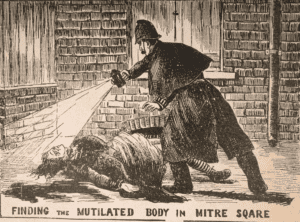
Illustration from “The Illustrated Police News”, 6 October 1888. - Additionally, there were many more dark alleys for criminals to operate in because lighting was scarce and didn't shine as brightly as it does now. Today, searching for DNA evidence is the initial step in practically any criminal investigation. In the 1980s, 100 years after the horrifying Jack the Ripper killings, DNA technology began to be used. With fingerprint profiling at best little understood and no ability to objectively demonstrate someone's presence at the crime scene through DNA, indicates that police tactics at the time were rudimentary. Instead, to create a criminal profile, eyewitness accounts and observations about the killings were mainly used.
Police Force Politics
- The cops and inspectors engaged in the Jack the Ripper case received harsh criticism at the time of the murders and continue to be scrutinized for their actions to this day. Some people think the Jack the Ripper inquiry would have been more cohesive if police politics had been handled differently.
- Numerous police chiefs and inspectors fought over jurisdiction when The Ripper's victims were discovered in various London police districts. Add to this the disgruntlement seen between Chief Commissioner of the Metropolitan Police, Sir Charles Warren, and the Home Secretary, Henry Matthews, and it’s easy to see how things got nasty when pursuing the serial murders.
- Jack the Ripper's police records were at best disorganised due to the large number of cops involved. Numerous original Jack the Ripper police files have vanished since the murders, which seems unbelievable given that a serial killer was at large.
Jack the Ripper Suspects
- The identity of Jack the Ripper is still a mystery more than 130 years after the horrific Whitechapel Murders. While some Jack the Ripper candidates have compelling biographies that seem to suit the killings committed during those terrible three years, some are less well-known, and some are just plain bizarre.
Carl Feigenbaum
- It's doubtful that anyone is aware of who Carl Feigenbaum really is. He reportedly underwent multiple name changes. After carrying out the terrible murder of Mrs Juliana Hoffman, his landlady, in 1894, Carl was executed by electric chair. Carl was discovered early one morning standing over her body while carrying a sizable carving knife.
- Carl allegedly had a desire to mutilate women, just like Jack the Ripper. He also knew more about human anatomy than most people. The fact that Catherine Eddowes, the fourth victim of Jack the Ripper, was murdered close to St Katherine and the London docks is another reason Carl Feigenbaum is suspected.
Joseph Barnett
- Mary Jane Kelly, a victim of the Ripper, once dated Joseph Barnett. He is the only known suspect with a direct connection to one of the victims.
- Some of the standards put forward by criminal profilers are met by Barnett. John E. Douglas, a profiler for the National Centre for the Analysis of Violent Crime, created an FBI profile on Jack the Ripper in 1988.
Prince Albert Victor
- Second in line to the British throne was Prince Albert Victor, the Queen's grandson. Though the Prince had a glorious future ahead of him, things rapidly turned sour.
- He was mainly regarded as a disappointment to the Royal Family before his untimely death in 1892 at the age of only 28 due to a stagnating military career, lethargic disposition, and rumours of homosexuality.
- Prince Albert Victor's later years and life are the subject of great suspicion, not the least because of his alleged involvement with Jack the Ripper and the Whitechapel Murders.
Montague John Druitt
- At first glance, this wealthy man with a passion for law and athletics would appear to have little to do with the horrific story of Jack the Ripper. However, Druitt's untimely passing brought his name into the public eye.
- Rumours that Jack the Ripper had drowned in the River Thames started to spread after the murder of Mary Jane Kelly, the last of the Canonical Five Ripper victims.
- Later, in 1891, West Dorset's MP Henry Richard Farquharson made it known that the Ripper was the son of a surgeon who had killed himself after Kelly was brutally murdered. He didn't say his name, but the circumstances and the description made Druitt the obvious choice.
Image Sources
- https://upload.wikimedia.org/wikipedia/commons/a/a1/JacktheRipper1888.jpg
- https://upload.wikimedia.org/wikipedia/commons/9/91/Annie_Chapman_1869.jpg
- https://upload.wikimedia.org/wikipedia/commons/a/af/The_Penny_Illustrated_Paper_-_October_13%2C_1888_-_Kate_Eddowes.jpg
- https://upload.wikimedia.org/wikipedia/commons/a/a0/Illustrated_Police_News_-_Jack_the_Ripper_2.png

